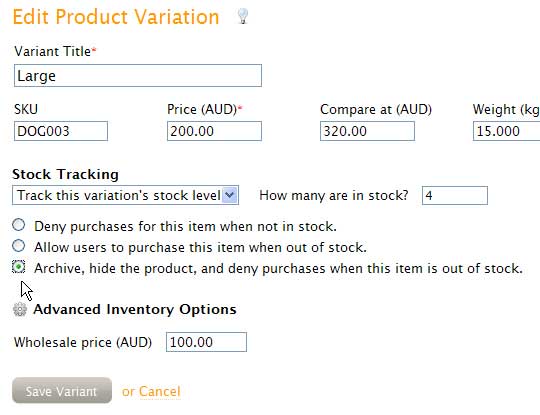Our new software release is now out the door, so it’s time to sit back and take the opportunity to highlight some of the new features.
Now inventory management might not be the most exciting topic in the world, but it’s one of the essential aspects of running your own online e-commmerce store. We’re constantly trying to do is to find innovative solutions to the problems you face as a store owner. We believe that we’ve come up with some unique enhancements to the way that we deal with inventory management that you won’t find anywhere else.

This image shows a product with a couple of variations, both under inventory management and you can see under the quantity heading how many items are available for sale. This is the level of inventory management that you will normally see.
However, this is not really the full story. Inevitably you will actually have more items sitting on your shelves than is show in the quantity field. These will be all the items that have been ordered, but not yet shipped. For example, you may be waiting for a bank deposit payment or a cheque to be cleared. So all these unshipped orders represent items from your inventory that are being held in reserve
awaiting shipment.

Here you can see that the list of products now shows the items in stock and the items that need to be shipped. For the Large Dog
there are 4 items available for sale, and 4 items that have been ordered but not shipped.

If we look at one of the unshipped orders, then we can see that it shows the total inventory for each item. So for this item, we have a total inventory of 8 items, representing the 4 items available for sale and the 4 unshipped items. As you can see, you now can see an accurate inventory level when you process each order. When you go to the shelf to pick up your Large Cute Dog
, you should see 8 of them sitting on the shelf.
When an order can’t be completed because you haven’t received payment, then you need to cancel the order. This means that the unshipped inventory gets transferred back to the inventory quantity that is available for sale, so you don’t need to manually adjust these levels when orders fall through.
The New Hidden Inventory Option
We’ve introduced a additional option for inventory management, and you’ll see this when you go to create or edit a product variation.

When you choose to track your inventory, the options have been to either allow or deny purchases when there is no stock available.
There is now a new option, Archive
, and this option says to deny purchases when out of stock, but to also archive
the product.
When a product is archived, it will no longer appear in any collection, search result or in the related products list. The product still exists and you can go directly to the product page if you know what the URL address is, but for a customer browsing through your store, the product will not appear. Once the stock level is back above zero, then the product will appear normally.
This feature will be useful for products that have a limited supply, such as hand-made or unique items. Once the item has been sold, then it automatically gets transferred to archive status and your customers won’t be constantly finding out of stock items that they can’t purchase.
Our Super Collections contain an Archive attribute, so you can build a special “Archived products” collection which will contain all the archived products. This can be used as a gallery option to display products that are no longer for sale.
One word of warning. If you have multiple variations, then if any of the variations have archive status then the whole product is archived. This means that the archive option is most useful for unique products with only one variation.
What I would really like to see is this: if an item is sold out, it says SOLD OUT instead of showing the price underneath the product. With our type of site, customers still like to compare styles and may like to request a special order. It would be good for us if they could see the item is sold out before clicking on it, rather than archiving so it can’t be seen.
Another handy feature would be if the back-end search engine recognised the SKU.
Paul,
This is easy to achieve. You need to edit the collection.liquid template and add some logic around the price display.
You can use the variable “product.available” to test whether a product is sold out or not.
For example…
[html]
<div class="money">
{% if product.available %}
{{ product.price_min | money }}{% if product.compare_at_price_max > product.price %}
<div class="original-price">{{ product.compare_at_price_max | money }}</div>{% endif %}
{% else %}
Sold out!
{% endif %}
</div>
[/html]
Adding the SKU to the search results sounds like a good idea.
Well look at adding the SKU to the search engine as soon as possible.
Brian